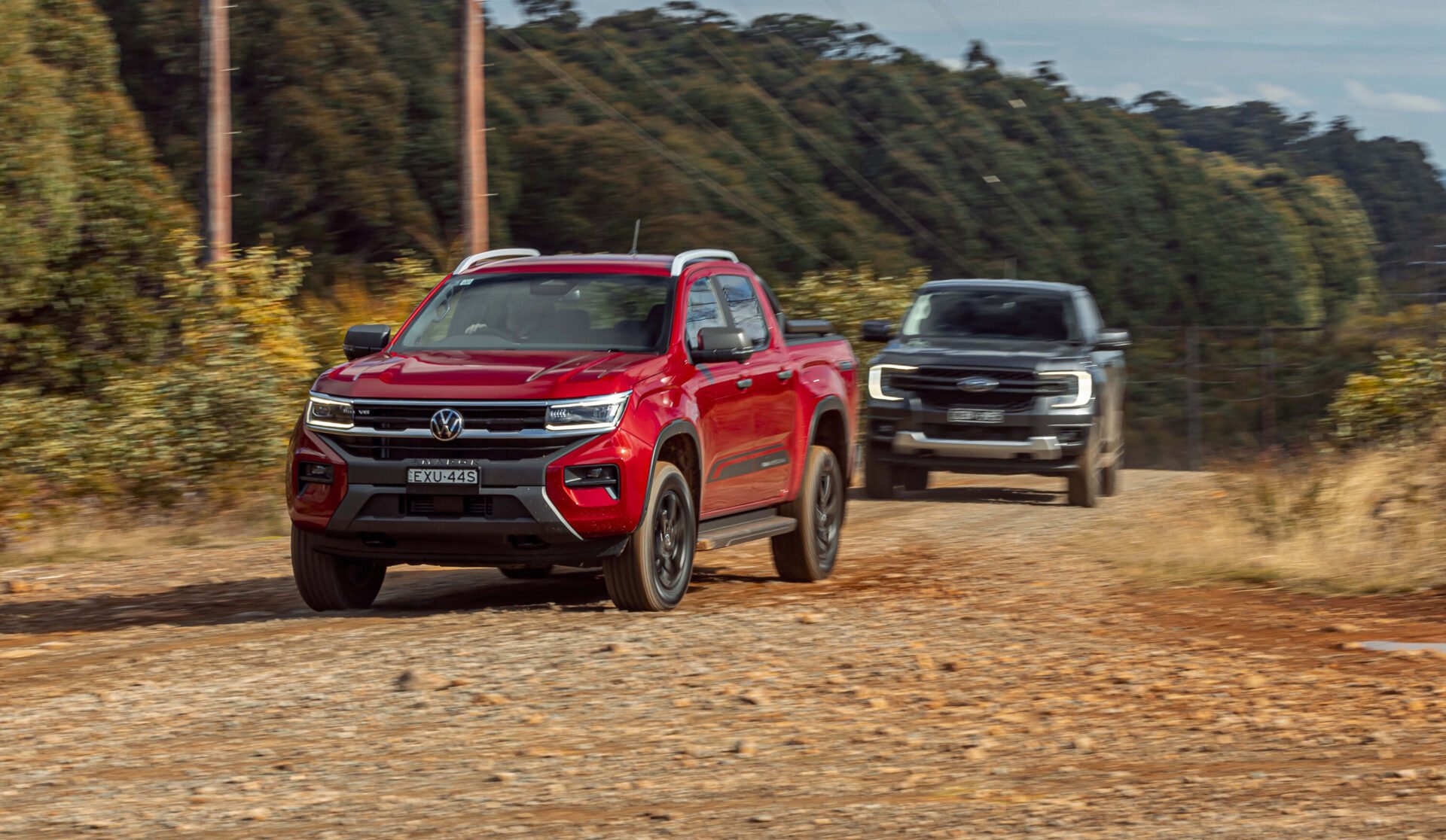
Things we like
- RANGER: Feels authentic, great value, relaxed ride, physical air-con switches
- AMAROK: Sharp styling, focused on-road, great interior, drive modes
Not so much
- RANGER: Drive mode controller finicky, no TPMS, flaky phone mirroring, smaller display
- AMAROK: Ride can be too firm off-road, intrusive AEB, no 12V in tub, A/C controls on screen
Twins under the skin, but some key differences make it a question worth asking…
Ranger or Amarok, which is the one to have? To decide, we’ve got the Ranger Sport V6 and the Amarok Panamericana (with the same V6).

Unless you’ve been living under a rock for the last year or so, you’ll know that the new generation of Volkswagen Amarok has sprouted from the bones of the class-leading Ford Ranger that was launched last year.
The guts of the Amarok range uses the same 2.0-litre Biturbo and 3.0-litre V6 diesel engines as the Ranger but, to add a bit of spice, Volkswagen also offers the 2.3-litre Ecoboost petrol engine that we’ve seen beneath the bonnet of the Mustang as a range-topper.
We’ve driven the Amarok overseas and on its local launch event, but were intrigued as to how it’d shape up against the Ranger.
To that end, we’ve chosen the penultimate Amarok model, the Panamericana.

This is supplied solely with the 184kW/600Nm 3.0-litre V6 and majors, according to Volkswagen’s marketing blurb, on off-road and design, “built to traverse every inch of the country with ease”. Given that you’d need to get through 11,924,954,915,322 square inches of this country to verify that claim, maybe we’ll take them at their word.
Priced at $75,990 (all figures here are before on-road costs), the Amarok is a few grand more than its natural rival, the $70,990 Ranger Wildtrak V6. Unfortunately, Ford was fresh out of Wildtrak demonstrators and so we had to settle for the next version down the ladder, the $66,690 Sport V6.
So you may need to squint and pretend that our Sport has Wildtrak-specific features like roof rails, a sports hoop, a power roller shutter and a 12-inch central touchscreen.
Mini match-up: Off-road stats
| Ranger Sport V6 | Amarok Panamericana | Hilux Rugged X | |
|---|---|---|---|
| Approach Angle | 30 | 30 | 31 |
| Breakover Angle | 22 | 22 | 24 |
| Departure Angle | 25.6 | 25.6 | 23 |
| Ground clearance (mm) | 235 | 235 | 236 |
| Wading depth (mm) | 800 | 800 | 700 |
JUMP AHEAD

Price and equipment
‘You may need to squint and pretend that our Sport has Wildtrak-specific features like roof rails, a sports hoop, a power roller shutter and a 12-inch central touchscreen.’
That’s not to say the Ranger Sport is in any way a bit light on the gear.
Your $66,990 gets you the best engine in the line-up, the fiendishly clever automatic four-wheel-drive system mated to a 10-speed auto transmission, 18-inch alloy wheels, LED lights all round, and the useful rear bumper side steps, allowing easy access to the sizeable drop-in bedliner.
It also scores gear you’ll search for in vain on the Volkswagen, although for features such as a soft-open tailgate and overhead auxiliary switches, you’d need to put your hand in your pocket for the $76,990 Ranger Platinum range-topper.
On the inside, there’s leather trim for the steering wheel and seat bolsters, a 10.1-inch centre screen and wireless charging for your phone and wireless connection to both Android Auto and Apple CarPlay. Active Park Assist and a 360-degree camera are the only safety elements that the Sport misses out on compared to the Wildtrak, which offers a huge safety suite.

Jump into the Amarok and it feels a little discombobulating. At first, I struggled to figure out why, then I remembered the first time I travelled to the United States.
Because Americans spoke English, my feeble brain reasoned, they were much like us. We understood their culture. Wrong.
The superficial similarities had me bamboozled and I realised that Americans were, to this Englishman anyway, a far more foreign bunch than, say, Belgians or Swedes.
As you gaze around the cabin of the Amarok, your eye lands on the Ford-spec gear selector and the upright centre touchscreen. You’ll spot FoMoCo logos on the glass and the squeeze-to-operate door pulls, and you’ll start to think it’s just a Ranger in dress-up. Then you begin to appreciate that things are more different than you first realised. A lot different.

The Amarok’s Digital Cockpit Pro screen in the dash binnacle is also a heck of a lot slicker than the Ranger’s slightly clunky graphical treatment.
The entire centre console stack is broader and more substantial, the indicators are on the other side, the drive mode selector is now in the touchscreen rather than a physical dial, and so are the heating and air-con controls.
Volkswagen has also revamped the entire touchscreen system, and the 1920×720 pixel landscape-oriented Digital Cockpit Pro screen in the dash binnacle is also a heck of a lot slicker than the Ranger’s slightly clunky graphical treatment.
There’s standard tyre pressuring monitoring, a 640W eight-speaker Harman Kardon stereo system and the array of knurled tabs that sit beneath the centre touchscreen feel lovely to the touch.

Its brightwork design mirrors a C-shaped motif used throughout the vehicle, such as on the air vents and headlights, while the knurled edges share the same pattern as seen on the side steps.
If you ever come away from a vehicle with an impression of inherent quality and cohesion, it’s often down to sophisticated design sleight-of-hand like this.
The brown ‘cricket leather’ interior with its intricate double-stitching is the brainchild of Albert-Johann Kirzinger, who also worked on the team that developed the striking baseball glove leather upholstery for the first-gen Audi TT.

Step out of the Amarok, park it next to the Ranger and although the basic proportioning is naturally similar, the details are also quite divergent.
With its bluff front end and round wheel arches, the Ranger looks resolutely F-150-lite American, even if it has been designed in Australia for Australians and built in Thailand.
The Amarok, with its beakier front end and huge, squared-off wheel arches is arguably a more interesting vehicle to behold. The surfacing is more aggressive, although the mirror finish 4Motion decals applied to this red and black vehicle can probably get in the bin.
A big sports bar and contrasting roof rails contribute to the Amarok’s glitzy aesthetic. Park this pair of utes side by side and most would probably think the Amarok was a lot more than $9K more expensive.
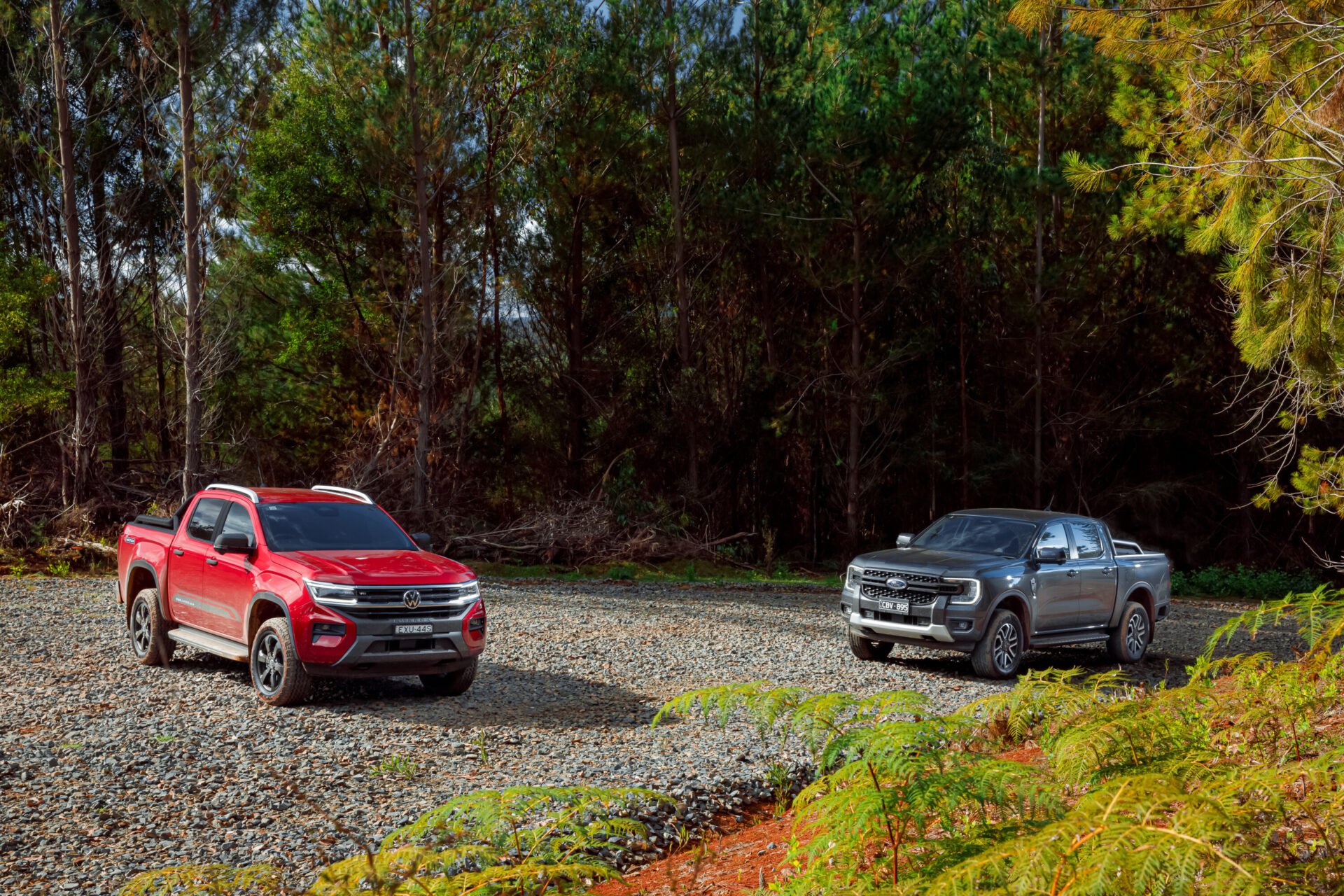
Comfort and space
If there is one downside of the Volkswagen’s industrial-strength centre console, it’s that the driver’s footwell feels a little more cramped.
I know ‘manspreading’ isn’t the most delicate of concepts, but on a hot day, you’ll appreciate having a little more room to sprawl in the Ford. The width across from centre console to door is 60cm in the Ranger and 53cm in the Amarok.
Getting into both vehicles requires quite a hike up onto the side steps. We’re not sure if Volkswagen is trying to troll Ford, but it claims a millimetre more ground clearance for the Amarok versus the Ranger (235mm vs 234mm).
The Ford’s then easier to flop into; the big bolsters of the Volkswagen’s seat cushions are a little more obstructive. They’re so soft in any case that they don’t offer a great deal of lateral support. Both vehicles offer excellent visibility, with big mirrors and a commanding ride height.

Ford should be commended for resisting the urge to migrate the HVAC controls into the touchscreen functions, as the chunky knobs for its dual zones are excellent. It’s not all gravy though.
The Ranger’s heated seat controls are still operated by haptic on-screen sliders, which are the devil’s own work. By contrast, the Amarok has an icon that you can prang either once, twice or three times to set the strength of the seat heaters from tepid to surface of Venus.
Likewise, it seems a bit of a miss on Volkswagen’s part to bring the drive modes into the touchscreen. In practice, it’s anything but. Hit the physical drive mode button and then select the on-screen mode and you’re in, quickly and easily.

By contrast, the Ford forces you to use a rotary controller and then switch into each mode in turn to eventually get where you need to be. Given there are six of ’em, that can take some time.
Each ute runs a version of Ford’s Sync 4 system, Volkswagen’s iteration heavily reskinned. It’s a very good system but can be prone to dropping the wireless phone mirroring connection on occasion and then being unable to reacquire it without a hard reboot.
Moving backwards, rear legroom in the Amarok is marginally more generous than that of the Ford. We measured maximum and minimums (not seat pitch per se, but the distance from the front of the rear seat cushion to the seat ahead) at 140mm and 380mm for the Volkswagen, with the Ford measuring between 120mm and 350mm.
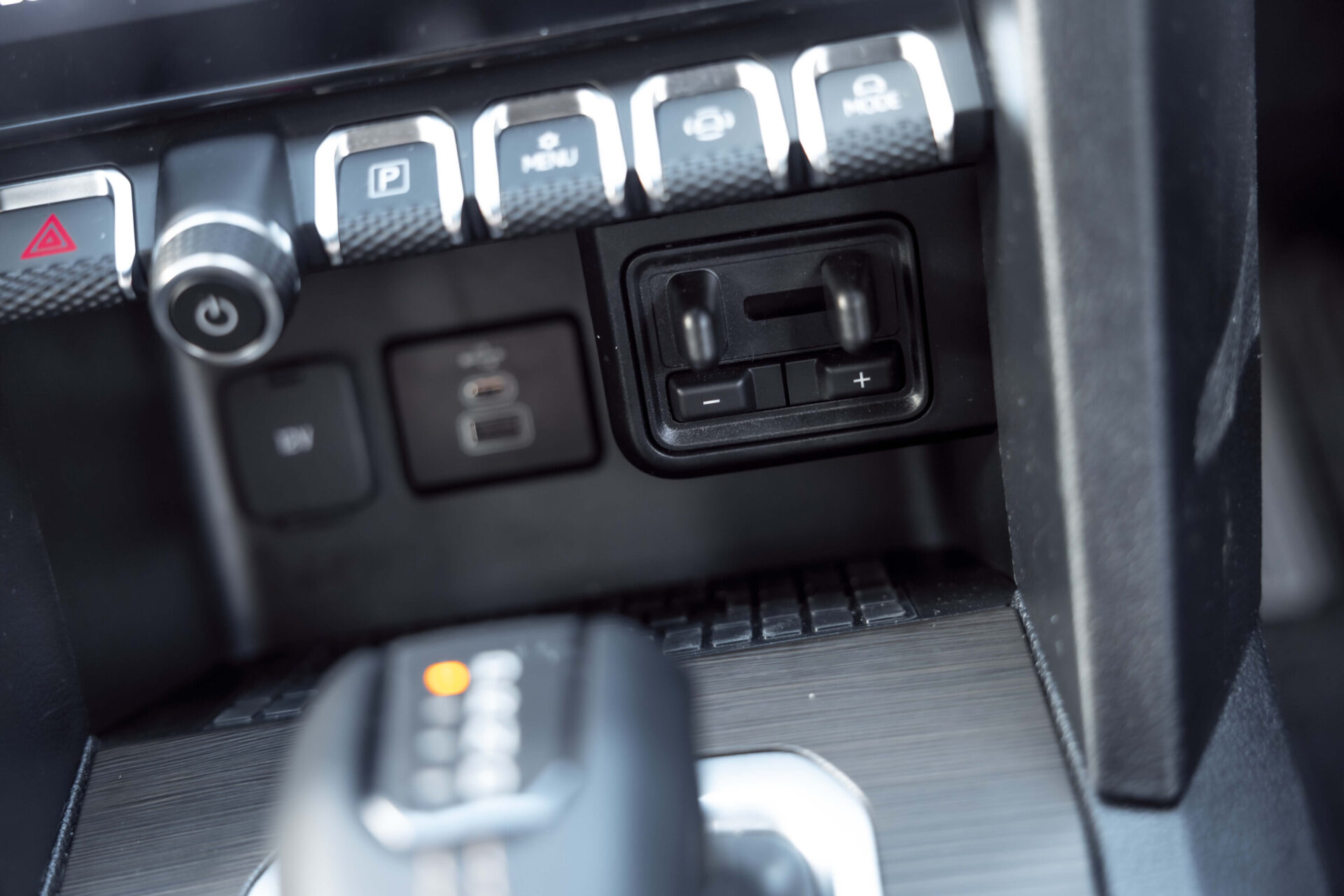
Access to the rear seats in both is reasonably good, although the Amarok’s wider side steps (150mm versus 138mm) means that if you’re leaning into the vehicle, it’s possible to shin yourself pretty painfully on the steps.
That’ll likely only happen once before you wise up. Both vehicles have rear vents but there’s no USB connection in the back of the Amarok.
There are bottle holders in the door pockets, two cup holders in the centre armrest and ISOFIX child seat fixings in the two outer positions though.

Both vehicles’ trays feature lined load bays and are scaled to fit a Euro pallet, with a 1217mm width between the wheelhouses on the Ranger and 1224mm on the Amarok.
The Amarok features a ruler on its tailgate as well as six tie-downs and LED lighting but, curiously, no 12-volt connection. That seems a strange oversight. There’s also a 3.5-tonne rated tow bar on the Panamericana as well as a 12-pin trailer plug.
The Ranger’s steps, notched into the side of the wraparound rear bumpers, are a piece of intellectual property that Dearborn was clearly not willing to cede to Wolfsburg, and they make jumping into the back of the tray very easy.
Although the Ranger lacks the flashy sports bar of the Amarok Panamericana, as indeed does the more expensive Wildtrak, the latter counters with zone lighting and the clever overhead auxiliary switch bank. Ford’s ingenious automated trailer light sequence check is another neat piece of thinking.
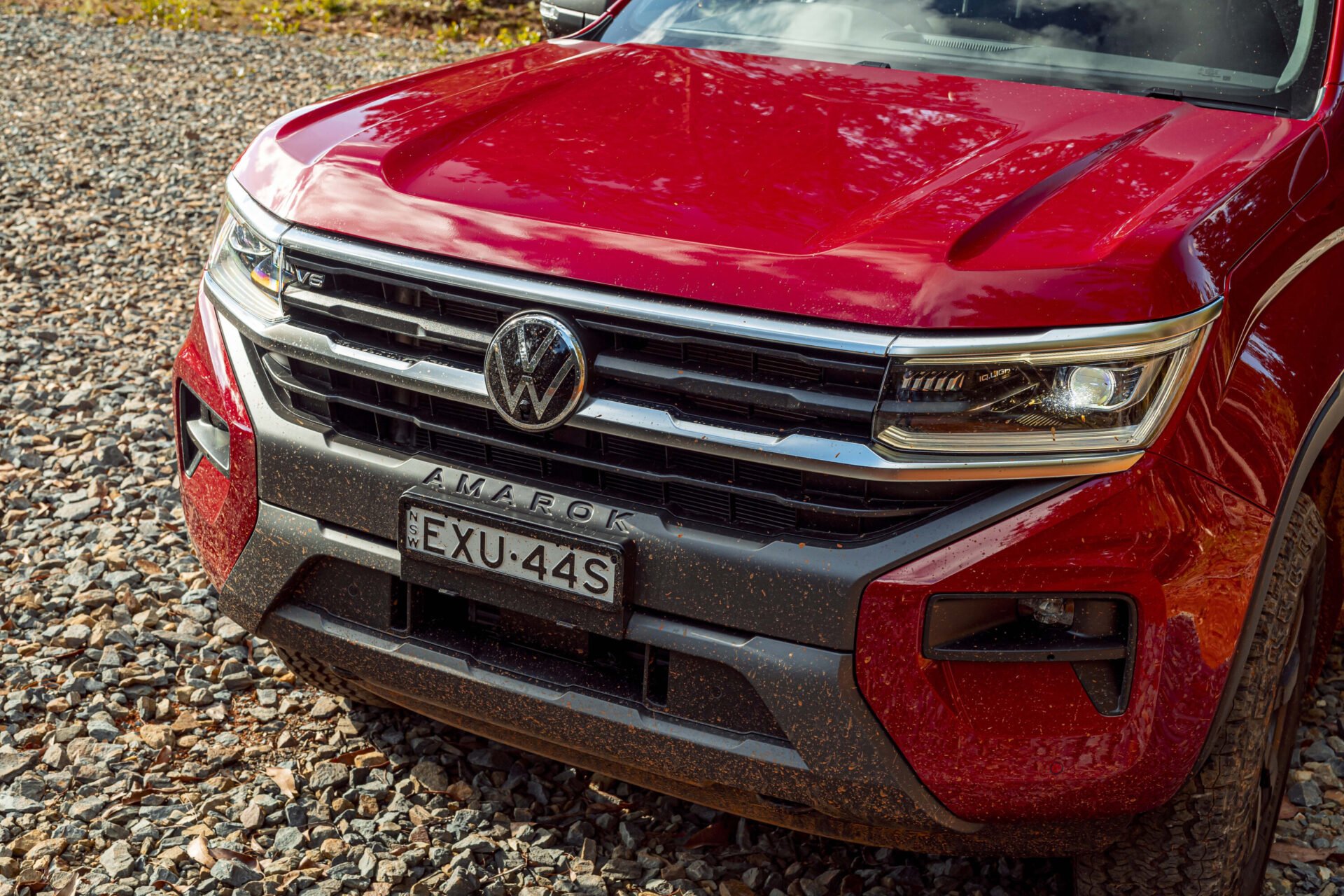
On the road
Given that both the Amarok and Ranger share engine, chassis, transmission and even the same tyres, you might think that there’s very little to choose between them in the way they drive.
And, by and large, you’d be right. However, there are some key differences that, while not immediately obvious, come to define how the two utes drive.
Most obvious is ride and handling. The Amarok Panamericana is fitted with the more expensive monotube dampers as standard – the Dynamic Suspension set-up – from Volkswagen. Amaroks from Style downwards get standard twin-tube dampers.
There’s little doubt that on-road, the Amarok feels a more planted thing through corners than the softer Ranger. On really bad bitumen, it can feel a bit crashy at times, but it’s a fun vehicle to hustle.
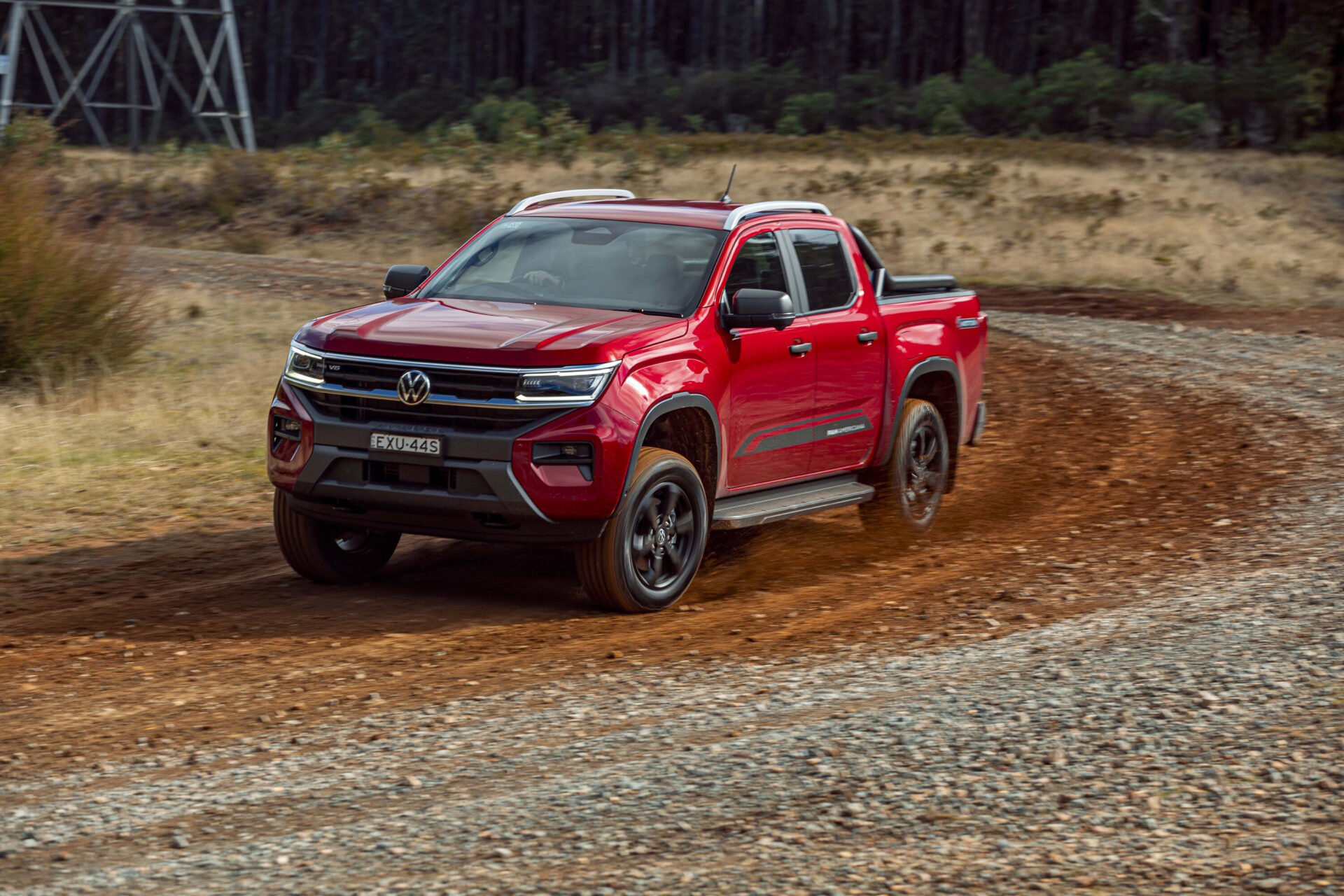
There’s little doubt that on-road, the Amarok feels a more planted thing through corners than the softer Ranger. On really bad bitumen, it can feel a bit crashy at times, but it’s a fun vehicle to hustle.
A flipside of this is that the Panamericana is the model designed for off-road adventures and here it can feel a little too firm for its own good. On the sharp, rocky descents of our test route, the Ranger felt as if it was gliding over the worst of the imperfections, while the Volkswagen transmitted every shock into the cabin.
When cornering on the loose, the Ford felt as though it had a huge envelope of malleability to lean into, whereas the Amarok felt as if it was up on its toes, requiring far more accuracy, skill and attention from its driver.
How much of an issue this proves clearly depends on how much of your use is away from metalled roads. On-road, we preferred the Amarok’s directness. Off-road, the Ford’s more benign feel was universally favoured. You pays your money…

Both are quick for a big pick-up.
The 3.0-litre engine’s prodigious torque (600Nm between 1750 and 2250rpm in both models) combined with a 10-speed automatic transmission with a new torque converter design and shift software means that finding yourself with a shortfall of Newton-metres is never a problem.
It also solves the gear-hunting issue the old ten-speed Rangers experienced and, if Ford is to be believed, the reliability issues that niggled at the 10R80 transmission.
The go part is really not an issue. Stopping neither. The Amarok is equipped with 340x235mm ventilated discs up front and dual-piston calipers, backed by 330x25mm ventilated discs aft with a single-pot sliding caliper. The Ford’s brakes are of a similar spec, with marginally larger diameter discs (341mm up front, 332mm at the back).

Both vehicles feature 80-litre fuel tanks, so offer meaningful range, resulting in a typical distance of 1000km between fills.
Braked towing is rated at 3500kg for both, and payload is more or less lineball too, 1030kg for the Ford, 1031kg for the Volkswagen. The Amarok features a 350kg static roof load and 350kg down ball weight for towing, which is up 50kg on the old model.
Selecting drive modes is quicker and easier in the Amarok than the Ranger. The Volkswagen features Normal, Eco, Slippery, Mud, Sand/Snow and Towing/Heavy Load modes, broadly mirroring those of the Ford. Both utes feature standard tyre pressure monitoring, which is a feature that those who air up and down while off-roading will find useful.
The Amarok’s forward collision alert system seems somewhat neurotic, sounding a loud and urgent beep when it thinks you’re about to rear-end something. It does this a little too frequently, such as filtering into a slip road off behind stationary traffic.
By contrast, Ford’s system seems a good deal more laidback. Otherwise, the safety systems work well, with both vehicles netting excellent surround-view cameras, well-calibrated adaptive cruise control systems and a five-star ANCAP rating.

VERDICT
This was always going to be one of those comparisons that lent itself to a horses-for-courses verdict.
If you want something that’s arguably more practical and rugged, go for the Ford. Want something more stylish but which can still roll its sleeves up when asked, pay the premium for the Volkswagen.
It’s instructive to consider quite what that premium is though. On paper, the Amarok Panamericana is around $5800 pricier than a Ranger Wildtrak, its obvious competitor. Both offer certain specification items that aren’t available on the other, but were you to add the desirable matrix LED headlights and premium audio system to the Ford to bring it closer to the Volkswagen’s specification, the difference looks more like $800.
Many would consider that a fair ask for a cabin that looks and feels a good deal more special than with the Ford, and gets you a bigger screen in the centre console plus a more extrovert exterior finish.
We’re no fence-sitters here at Wheels, but we’d offer the following conditional advice.
If you were planning on driving largely on-road and want something composed and civilised, spend the extra and buy the Volkswagen Amarok Panamericana.
If a decent percentage of your driving is on the loose, pocket the difference and choose the Ford Ranger.
Money no object? We’d go the Volkswagen – and take the edge off its ride by knocking a couple of pounds of pressure out of its tyres.
SCORING
Ford Ranger Sport V6: 8.5/10
Things we like
- Feels authentic
- Great value
- Relaxed ride quality
- Physical HVAC controls
Not so much
- Drive mode controller a bit finicky
- Infotainment can drop wireless Android Auto connection
- Central screen is smaller than VW’s
VW Amarok Panamericana: 8.5/10
Things we like
- Sharp exterior styling
- Focused on-road handling
- Interior execution
- Drive modes quick to access
Not so much
- Ride can be firm off-road
- Forward collision warning is intrusive
- No 12v in the tub
- HVAC controls in the touchscreen
SCORES
| Ford Ranger Sport V6 | Volkswagen Amarok Panamericana | |
|---|---|---|
| Safety, value and features | 9 | 8.5 |
| Comfort and space | 9 | 8.5 |
| Drivetrain | 8 | 8.5 |
| Ride and handling | 7.5 | 8 |
| Technology | 8.5 | 8.5 |
| OVERALL | 8.5 | 8.5 |
Specifications
| 2023 Ford Ranger Sport V6 | 2023 Volkswagen Amarok Panamericana | |
|---|---|---|
| Body | 4-door, 5-seat dual-cab ute | 4-door, 5-seat dual-cab ute |
| Drive | permanent four-wheel (automatic) | permanent four-wheel (automatic) |
| Engine | 3.0-litre V6 turbo-diesel | 3.0-litre V6 turbo-diesel |
| Transmission | 10-speed automatic | 10-speed automatic |
| Power | 184kW @ 3250rpm | 184kW @ 3250rpm |
| Torque | 600Nm @ 1750-2250rpm | 600Nm @ 1750-2250rpm |
| Bore stroke (mm) | 84.0 x 90.0mm | 84.0 x 90.0mm |
| Compression ratio | 16.0:1 | 16.0:1 |
| 0-100km/h | 9.5 sec (estimate) | 9.5 sec (estimate) |
| Fuel consumption | 8.4L/100km (combined) | 8.4L/100km (combined) |
| Weight | 2322kg | 2319kg |
| Suspension | MacPherson strut front/leaf spring rear | MacPherson strut front/leaf spring rear |
| L/W/H | 5370/1918/1884mm | 5350/1910/1886mm |
| Wheelbase | 3270mm | 3270mm |
| Fuel tank | 80 litres | 80 litres |
| Brakes | 341mm ventilated discs, two-piston calipers (f) 332mm ventilated discs, single-piston caliper (r) | 340mm ventilated discs, two-piston calipers (f) 330mm ventilated discs, single-piston caliper (r) |
| Tyres | 255/65 R18 Goodyear Wrangler Territory HT M+S | 255/65 R18 Goodyear Wrangler Territory HT M+S |
| Wheels | 18-inch alloy (full-size spare) | 18-inch alloy (full-size spare) |
| Price | $66,690 + on-road costs | $75,990 + on-road costs |




